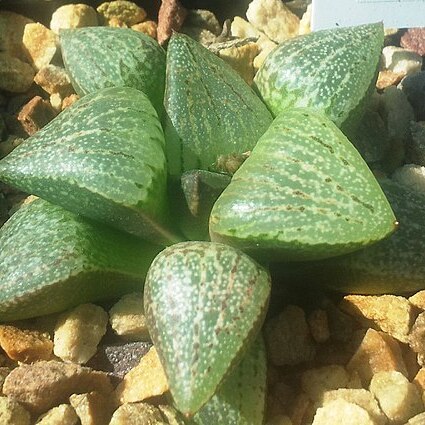Plants acaulescent, about 6 cm diam., few leaved. Leaves grey-green, nearly ovate to oblong, acuminate, rectangularly or nearly rectangularly truncate at the tip, about 3.5 cm long, 1.5 to 2.5 cm broad, about 16 mm thick, grey-green, not shining, the young erect, the older spreading; face below end-area slightly convex below, more convex above, smooth, grey-green; end-area about 2.5 cm long, 1.5 to 2 cm broad, pellucid, with numerous small pellucid, somewhat shining tubercles, with 5 to 8 indistinct longitudinal face lines; back surface convex, obliquely keeled towards the tip, with numerous roundish, not confluent, pellucid flecks; margins and keel rough to dentate. Inflorescence about 27 cm tall; peduncle simple, about 2 mm diam., bracteate; sterile bracts membranous, 6 mm long, erect, keeled; raceme about 18 cm long, lax, with about 18 spirally arranged flowers and buds, 6 to 8 open simultaneously; floral bracts membranous, 6 mm long, deltoid, acuminate, keeled with reddish-brown veins, clasping the pedicels, (longer than the pedicels); pedicels 2.75 mm long, 1 mm diam., green, erect; perianth white with green keels to the segments. 14 mm long, compressed at base, funnel-shaped, tube more or less 4 mm across, constricted to 3 mm above, curved; segments free to the base, limb 2 lipped; posterior segments little recurved, spreading, white with fine green veins; stamens 6 of two lengths, 6 and 7 mm long, inserted within the perianth tube; ovary 6 mm long, 2 mm diam., green; style 1.5 mm long, white, curved, not capitate.
Plant stemless, with few leaves and about 6 cm in diam. Leaves ovate-oblong, acuminate, green, 3.5-4.5 cm long, the upper part rectangularly recurved, the triangular face almost flat, 2-2.5 cm long and 1.5-2 cm wide at the base, pellucid, with numerous, only slightly raised, shiny tubercles, and numerous, very minute whitish flecks, and with 5-8 inconspicuous, whitish lengthwise lines, back of leaves very rounded, obliquely keeled, in the upper part towards the margins with numerous rounded small whitish spots which occasionally assume the form of tubercles, the margins of the faces crenulately roughened, the lower margins and the keel near the tip with minute teeth, the tip ending in a 3 mm long, pellucid bristle.
Always growing solitary. Rosette: acaulescent, 45-65 mm diam. Leaves: 8-13, fleshy, reading, end-area bent back, 17-22 mm long, 15-20 mm broad, 13-15 mm thick. Leaf colour: back and leaf-base, smooth, opaque, green, orange-brown in strong sunlight. Margins: opaque, smooth. Back with 1 smooth, opaque and concoloured keel. End-areas: 18-20 mm long, face hardly translucent, with 7-8 parallel lines and numerous whitish, brownish and orange-brown flecks. Leaf-tip: with end-bristle, 1-2 mm long.
Always growing solitary. Rosette: acaulescent, 50-80 mm diam. Leaves: 8-15, fleshy, spreading, end-area bent back, 25-35 mm long, 20-25 mm broad, 10-15 mm thick. Leaf colour: back and leaf-base smooth, opaque, green, orange-brown under strong light. Margins: opaque, smooth. Back with 1 smooth, opaque and concoloured keel. End-areas: 20-25 mm long, face translucent, with 4-7 parallel lines and numerous silvery flecks. Leaf-tip: with a 0.5 mm long tooth.

